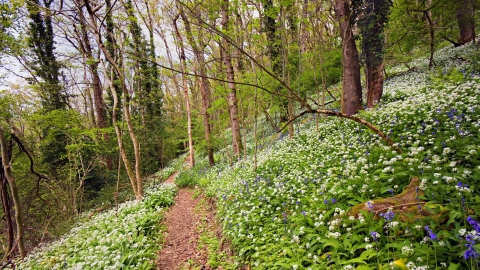
Scanniclift copse. Photo, Dave Chamberlain
Scanniclift Copse
Know before you go
Dogs
When to visit
Opening times
Open at all timesBest time to visit
March to SeptemberAbout the reserve
The reserve is one such small, but well connected, woodland nestling on the sharply rising valley sides, overlooking the hedged pastures of DWT's Woodah Farm.
A permissive path along a quiet lane and track brings you to the site entrance. Follow the 1km circular trail, which in places is narrow, winding and steep, with several sections of steps, through the 8 hectares of woodland. It may take only an hour to walk round, up and down, but there is much to see on the way.
Ash dieback
The disease ash dieback is now widespread in the UK and is present at many of our nature reserves, so we carry out tree felling across our sites in winter months. For your own safety please observe temporary path diversions and closures.
Where possible we will leave affected ash trees in place to decay naturally as an important habitat for wildlife. We plan to only fell diseased ash trees which pose a threat to people or infrastructure. Before trees are felled, we will check whether any rare or protected wildlife is present. If it is, we will postpone or avoid felling these trees. No felling will take place during the bird nesting season.
DWT’s Saving Devon’s Treescapes project are working with communities, landowners and businesses to help make Devon's precious treescapes more resilient in the face of ash dieback. Find out how you can get involved here.
NOTICE: If you are visiting our reserves, please note that there have been instances of H5N1 Avian bird flu found in birds in Devon. There is very low risk to public health, but we do ask that if you come across any unusual or unexplained bird deaths on or near our reserves, please do not touch them and avoid allowing your dog to come into contact with dead birds. Please report them to Defra here or call 03459 335577 and also report your findings to DWT by email at contactus@devonwildlifetrust.org.
Habitat
Contact us
Location map
How to get to Scanniclift Copse
Melanistic fallow deer. Photo, Mike Bartholomew
Scene from a certain angle
The slopes offer a different perspective, the chance to see both the top and bottom of a woodland, from treetops to leaf litter.
Veteran oaks, the larger trees over 300 years old, occupy the canopy, accompanied by ash on the upper slopes. Under a varied understorey of hazel coppice, holly, spindle, blackthorn, hawthorn, field maple, crab apple and suckering elm, you may glimpse melanistic fallow deer browsing among the soft shield and hart's-tongue ferns, while wood ants forage in the leaf litter below.
Scents and sensibilities
Scanniclift is a place to encounter the sights and sounds of a woodland, and also the smells: in spring the reserve is filled with colours and scents from flowers such as bluebells, bugle, wood anemone, woodruff, wood spurge, wild garlic and pignut.
More unusual plants recorded here include bastard balm, toothwort and bird's-nest orchid. The site is also special for rare beetles and other invertebrates which live in dead and rotting wood. Dead standing trees are purposely retained for the habitats they provide and create: natural windblow helps form glades and wet wood flushes.
A branch of history
Scanniclift Copse was bequeathed to Devon Wildlife Trust by Kathleen Dorothy Gifford Scott in 1984. Historically this was a working woodland; evidence of past coppicing, charcoal hearths and quarry caves can still be seen. Today the caves are home to rare horseshoe and barbastelle bats, well placed for an aerial commute along the Teign Valley.
Take your next step
From here it is a short trip to nearby Dunsford nature reserve for another Teign Valley riverside walk.
